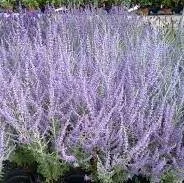butterfly pattern No. 2
butterfly Garden Pattern No. 2
Overview
Panicum ‘Hieleger Hain’ has good vertical, bluish green foliage, very architectural. This characteristic blends nicely with the lacey foliage of the Perovskia which will gently lay into the Panicum’s foliage. This creates a very relaxed look. Now add to that the medium blue flower spikes of the Perovskia. Now you’re stopping traffic! In September the Panicum has gentle open panicles of flowers moving gently in the slightest breeze. This grouping has so many possibilities of locations within your plantings. Also these two plants are slow to emerge creating good planting opportunities for bulbs. Try to use more species bulbs their foliage is not as large as many of the hybridized bulbs and won’t mat down and inhibit the emergence of the perennials in late April and early May.
Stewardship
No deadheading! These plants are always sharing their character and as they change their nature through the growing season. They are very active participants in the garden. Cut back everything in March before your bulbs come up. You can use a string trimmer cutting the plants down from top to bottom. Leave the plants leaf and stem remnants in the garden that’s their healthy mulch. Plants have been self-mulching since they appeared on Earth.
*These garden plans can be followed explicitly or adjusted to meet individual needs, unlocking rich perennial landscape designs for individualization and creativity.
Pattern profile:
Exposure: Sun
Colors: Yellow, Blue
Bloom Time: July - August
Panicum virgatum ‘Hieleger Hain’
Exposure: Sun/Part Shade
Color: Yellow
Height: 18” - 30”
Width: 24”
Bloom Time: Mid-July to Late September
POLLINATOR NOTES:
The Panicum is well received by native bees, native wasps, native flies and many moths.
Keep watch for Goldfinches, Cardinals, Chickadees and Nuthatches.
Perovskia ‘Blue Steel’
Exposure: Sun
Color: Blue
Height: 18” - 2o”
Width: 24”
Bloom Time: Late Summer
POLLINATOR NOTES:
The Perovskia is captivating to butterflies and good for many bees. There's not much specific information online about particular bees that favor



